To read pet food labels effectively, start by understanding the basics, like the Guaranteed Analysis, which shows protein, fat, and fiber percentages. Check the ingredient list; ingredients are listed by weight, so choose foods with high-quality, recognizable ingredients at the top. Look for AAFCO statements to confirm nutritional adequacy. Be cautious of marketing claims—terms like "natural" can be misleading. Pay attention to allergens and consider your pet's specific dietary needs. By focusing on these aspects, you can make informed choices to promote your pet's health and happiness, while there's plenty more to explore on this essential topic.
Key Takeaways
- Check for "complete and balanced" claims to ensure the food meets AAFCO nutritional standards for your pet's needs.
- Read the ingredient list from top to bottom, prioritizing high-quality proteins and avoiding fillers and artificial preservatives.
- Review the Guaranteed Analysis for essential nutrient levels like protein, fat, and fiber to ensure balanced nutrition.
- Be cautious of marketing terms; focus on specific ingredients and their nutritional benefits rather than attractive packaging.
- Consider any special dietary needs your pet may have, such as allergies, age, or health conditions, when selecting food.
Understanding Pet Food Label Basics
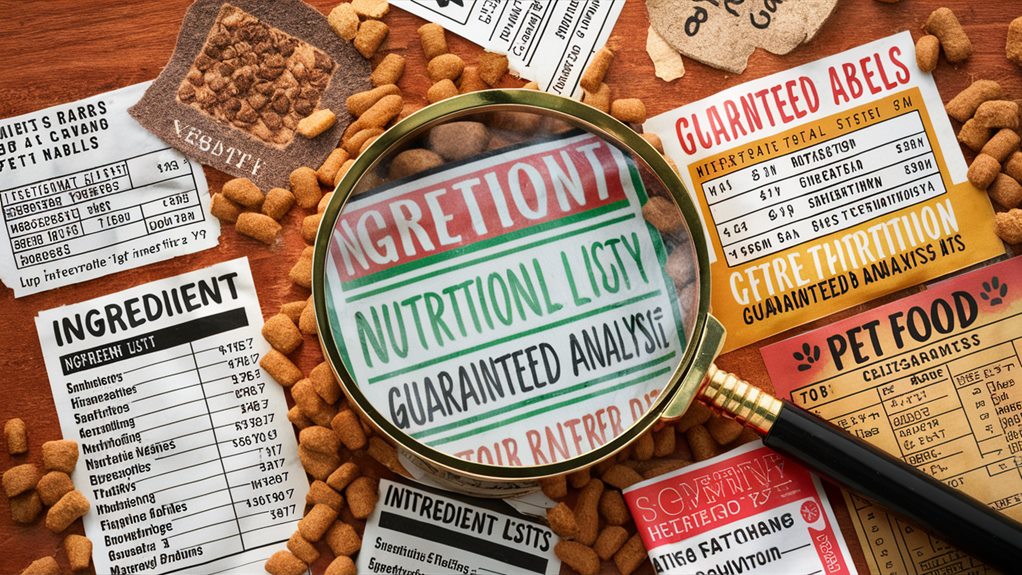
When it comes to choosing the right food for your pet, understanding pet food labels is essential. These labels provide critical information that can help you make informed decisions about your furry friend's nutrition. Familiarizing yourself with label requirements is the first step. The Association of American Feed Control Officials (AAFCO) sets guidelines that pet food manufacturers must follow. You'll see terms like "complete and balanced," which means the food meets specific nutritional standards for your pet's life stage.
Additionally, consider how the right materials for scratching posts can contribute to your pet's overall well-being by promoting healthy behaviors.
As you dive deeper into the label, pay close attention to the nutritional values. These values indicate the percentages of protein, fat, fiber, and moisture in the food. A high-quality pet food should contain appropriate levels of protein and fat, tailored to your pet's age, size, and activity level. For example, active dogs might require more protein, while senior pets may need lower fat content.
Additionally, notice the calorie content, as it can help you manage your pet's weight effectively. Understanding these values not only allows you to choose a healthier option but also fosters a sense of community with fellow pet owners who prioritize their pets' well-being. Discussing your findings and experiences with others can lead to better choices for all.
Decoding Ingredient Lists

Decoding ingredient lists is necessary for selecting the right pet food. When you examine these lists, the first thing to notice is the order of ingredients. They're listed by weight, so the first few items are the primary components of the food. High-quality protein sources should be near the top, like chicken or beef. Additionally, consider opting for brands that prioritize mindful eco-friendly practices in their ingredient sourcing.
Next, consider ingredient sourcing. It's ideal to know where these ingredients come from. Reputable brands often provide details about their sourcing practices, ensuring that they use fresh, local, and sustainable ingredients. This transparency helps you feel confident about what you're feeding your pet.
Processing methods are another significant factor. The way ingredients are processed can affect their nutritional value. Look for terms like "cold-pressed" or "freeze-dried," which generally indicate more natural preservation methods that retain nutrients. Avoid products that don't disclose their processing methods, as this may hint at lower quality or less desirable practices.
Additionally, watch out for fillers, artificial preservatives, and by-products. These can dilute the nutritional value of your pet's food and mightn't promote best health. Instead, aim for foods with whole ingredients that you can recognize and trust.
Recognizing Guaranteed Analysis
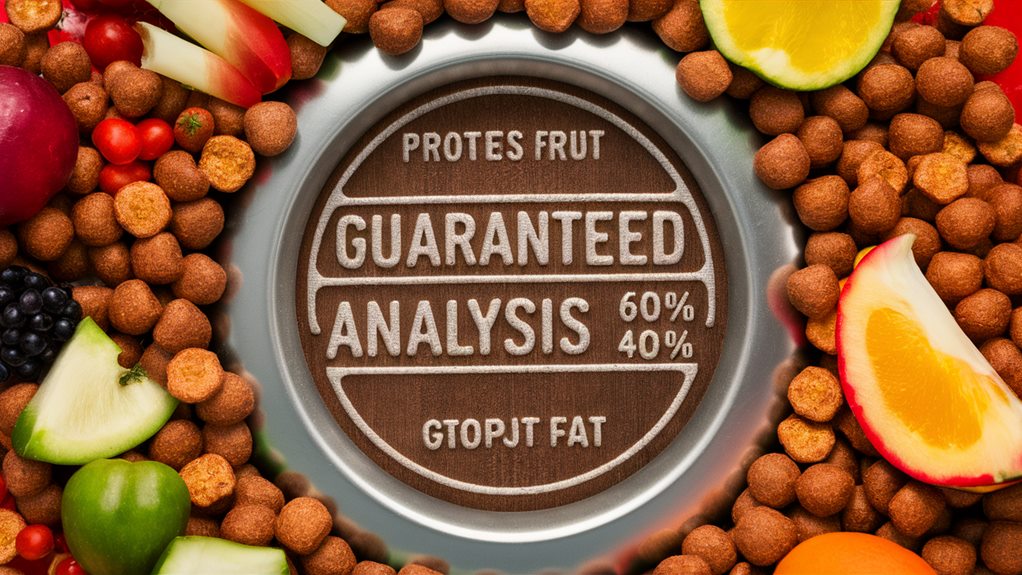
How can you ensure your pet is receiving the right nutrients? One effective way is by understanding the Guaranteed Analysis (GA) on pet food labels. This section provides essential information about the nutritional composition of the food, specifically detailing the protein content, fat content, fiber, and moisture levels. Recognizing the significance of this information can help you make informed decisions about your pet's diet and guarantee they receive the best possible nutrition, including compact power strip features that enhance your daily convenience.
When you look at the GA, focus first on the protein content. It's crucial for your pet's overall health, supporting everything from muscle development to immune function. A higher protein percentage often means a more nutritious product, but make sure it comes from quality sources.
Next, pay attention to the fat content. Fats are essential for energy and help absorb certain vitamins, but balance is key. Too much fat can lead to obesity, while too little can cause skin and coat issues.
Also, don't overlook the mineral levels in the GA. Minerals like calcium, phosphorus, and potassium are vital for strong bones, heart health, and overall bodily functions. Look for a balanced formulation that meets your pet's specific needs based on their age, size, and activity level.
Interpreting Nutritional Adequacy Statements

Understanding the Guaranteed Analysis is just the beginning of evaluating pet food; the Nutritional Adequacy Statement on the label plays a pivotal role in determining if a product meets your pet's dietary needs. This statement indicates whether the food is suitable for growth, maintenance, or special dietary needs, based on established standards.
When you look at the Nutritional Adequacy Statement, pay close attention to the claims made. You'll typically see phrases like "complete and balanced" or "intended for all life stages." These claims are crucial because they tell you if the food has been formulated to provide the necessary nutrients your pet requires.
Next, comparing values between different brands can help you make an informed decision. While one product may boast higher protein content, another might offer better overall balance with vitamins and minerals. It's essential to not just focus on one aspect; instead, consider the overall nutritional profile and how it aligns with your pet's specific needs.
Additionally, always double-check the claims made by the manufacturer. Look for specific details about the nutrient profile and any certifications that back their statements. A well-researched choice not only supports your pet's health but also brings peace of mind, knowing you've chosen a quality food.
Ultimately, understanding these statements helps you provide the best nutrition for your furry friend, enhancing their quality of life and happiness.
Identifying AAFCO Standards
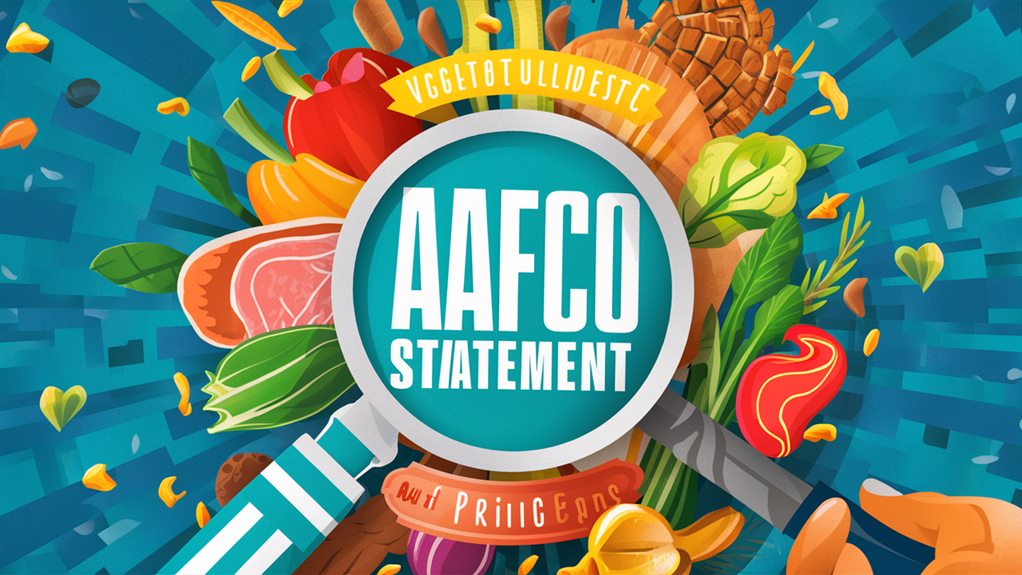
The Association of American Feed Control Officials (AAFCO) sets essential standards that guide pet food labeling and formulation. Understanding AAFCO requirements is important for anyone looking to provide their pets with best nutrition. When you read a pet food label, you want to verify that it meets these standards for both label accuracy and ingredient quality.
You should look for products that have undergone AAFCO testing, as this signifies that they've met specific nutritional balance criteria. AAFCO's regulations help guarantee that the food you choose contains the right nutrients for your furry friends, helping you feel confident in your choices.
Here are some key points to keep in mind:
- Peace of mind: Knowing that the food meets AAFCO standards can reduce your concerns about nutritional deficiencies.
- Trust in brands: Brands that adhere to AAFCO requirements demonstrate a commitment to quality and safety.
- Happy, healthy pets: Proper nutrition leads to a better quality of life for your pets, allowing them to thrive.
- Informed decisions: Understanding these standards empowers you to make choices that align with your pet's needs.
When evaluating pet food, always check for statements like "formulated to meet AAFCO standards" or "meets AAFCO nutrient profiles." By doing so, you'll verify that your pet receives food that not only meets AAFCO requirements but also prioritizes nutritional balance and ingredient quality. Your pets deserve the best, and you play an important role in their well-being.
Evaluating Feeding Guidelines
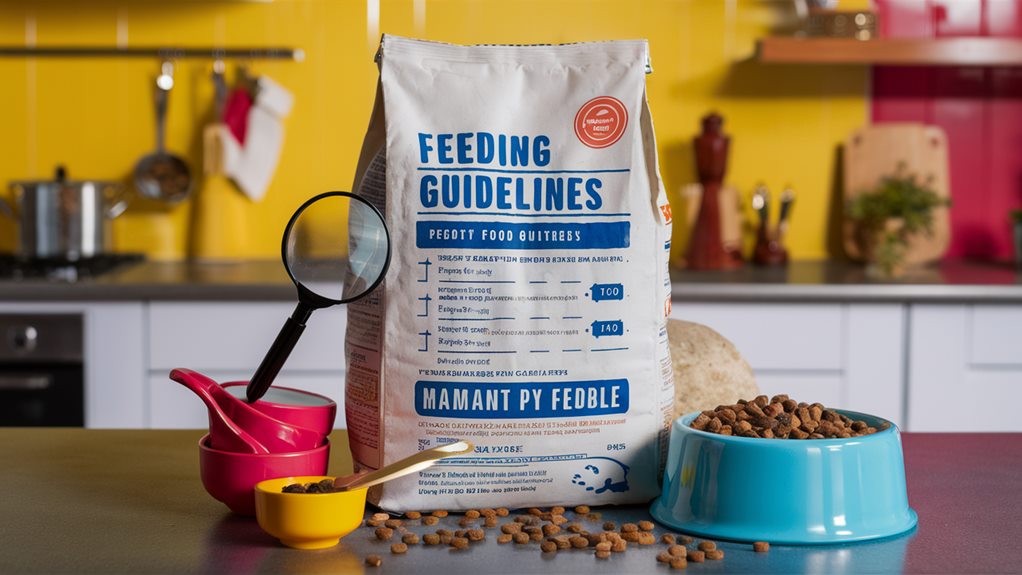
When evaluating your pet's feeding guidelines, it's crucial to take into consideration their specific nutritional needs and activity levels. Start by checking the serving size recommended on the food label, as it often serves as a baseline. However, keep in mind that these guidelines are just that—suggestions.
You'll need to adjust portions based on your pet's individual needs, especially if they've any dietary restrictions or health concerns. For example, if your pet is overweight, portion control becomes crucial for effective weight management. Reducing the quantity of food while maintaining proper nutritional balance can help promote a healthier lifestyle.
You can also consider high-quality foods that are nutrient-rich, allowing you to feed smaller portions without compromising on nutrition. If your pet has specific health concerns, such as allergies or sensitivities, consult with your veterinarian to tailor a diet that accommodates these needs. This may involve selecting specialized formulas designed for certain conditions.
Always monitor your pet's weight and adjust their food intake if you notice changes; regular weigh-ins can help you make informed decisions about their diet. Lastly, remember that each pet is unique. What works for one mightn't work for another. Keep an open line of communication with your vet and observe how your pet responds to their diet over time.
Spotting Marketing Claims
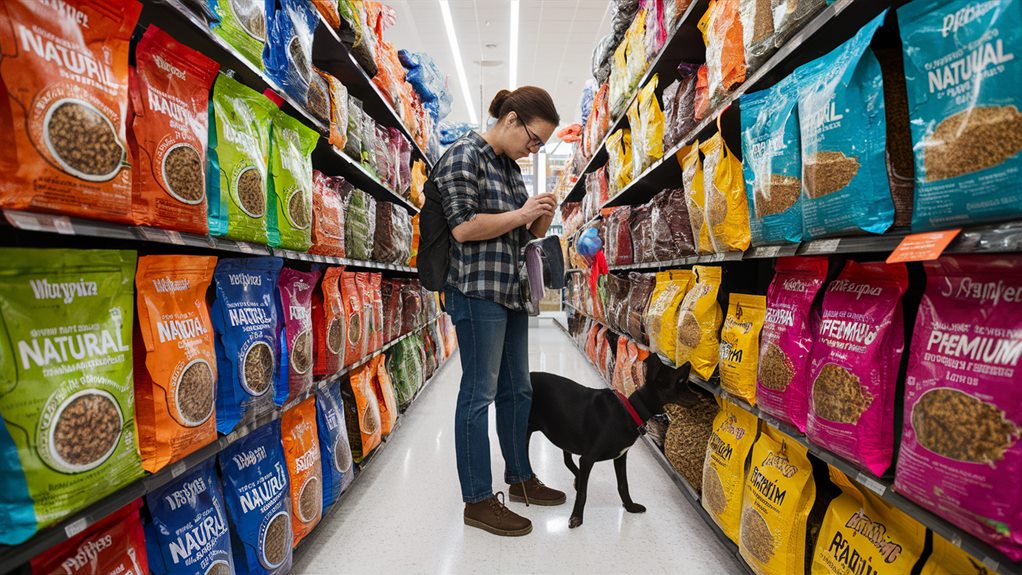
Deciphering pet food labels can be tricky, especially with the variety of marketing claims that can easily mislead pet owners. It's vital to approach these labels with a critical analysis mindset. Many brands use buzzwords that sound appealing but may not reflect the true nutritional value of the product. By recognizing these terms, you can avoid misconceptions that could harm your pet's health.
Here are some common buzzwords to watch out for:
- "Natural" – This term isn't regulated and can mean different things.
- "Holistic" – Often used to suggest overall health benefits without scientific backing.
- "Premium" – This label doesn't guarantee better quality ingredients.
- "Vet-approved" – It may be true, but it doesn't imply that it's the best choice for your pet.
When you see these claims, it's vital to dig deeper. Instead of getting swayed by attractive packaging and catchy phrases, look for solid evidence of nutritional benefits. Check the ingredient list and look for specific nutrients rather than vague promises. By seeing through advertising, you empower yourself to make smarter choices for your furry friend.
Engaging with your pet's dietary needs in a knowledgeable way fosters a sense of community among other pet owners who prioritize their pets' health. Remember, you're not just feeding a pet; you're nurturing a beloved member of your family.
Assessing Allergen Information

Evaluating allergen details on pet food labels is important for ensuring your pet's health and well-being. Many pets can develop allergies or sensitivities to specific ingredients, which can lead to various health issues. It's vital to pay attention to allergen warnings and the ingredient sources listed on the label.
When reviewing a pet food label, look for common allergens such as wheat, soy, corn, and certain animal proteins. Here's a helpful table to assist you in identifying potential allergens in pet foods:
| Allergen Type | Common Ingredient Sources |
|---|---|
| Grains | Wheat, Barley, Corn |
| Animal Proteins | Chicken, Beef, Fish |
| Dairy | Milk, Cheese, Yogurt |
| Artificial Additives | Preservatives, Colorings, Flavors |
If your pet has a known allergy, always consult the allergen warnings on the packaging. This information can help you avoid harmful ingredients that could lead to reactions like skin irritations or digestive upset. Remember, even if a food is labeled as "grain-free," it might still contain other allergens, so read the ingredient list carefully.
Considering Special Dietary Needs
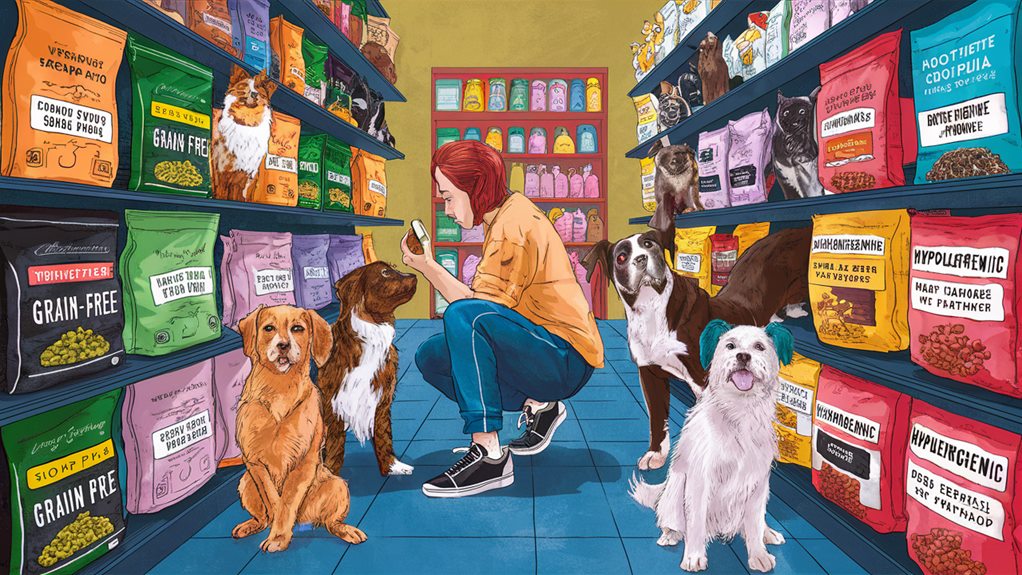
Understanding your pet's specific dietary needs is just as crucial as identifying allergens. Each animal has unique requirements based on age, breed, health status, and lifestyle. By being proactive about these needs, you can guarantee your furry friend thrives.
When you're reading pet food labels, pay attention to any dietary restrictions your pet may have. This can range from allergies to sensitivities or specific health conditions like diabetes or kidney disease. Choosing the right food can lead to significant health benefits, enhancing your pet's quality of life. Consider these factors:
- Age: Puppies and senior pets have different nutritional requirements.
- Breed: Certain breeds may be prone to specific health issues requiring special diets.
- Weight Management: Obesity is an increasing concern; a tailored diet can help maintain a healthy weight.
- Medical Conditions: Conditions like allergies, diabetes, or gastrointestinal issues necessitate special formulations.
Making Informed Choices
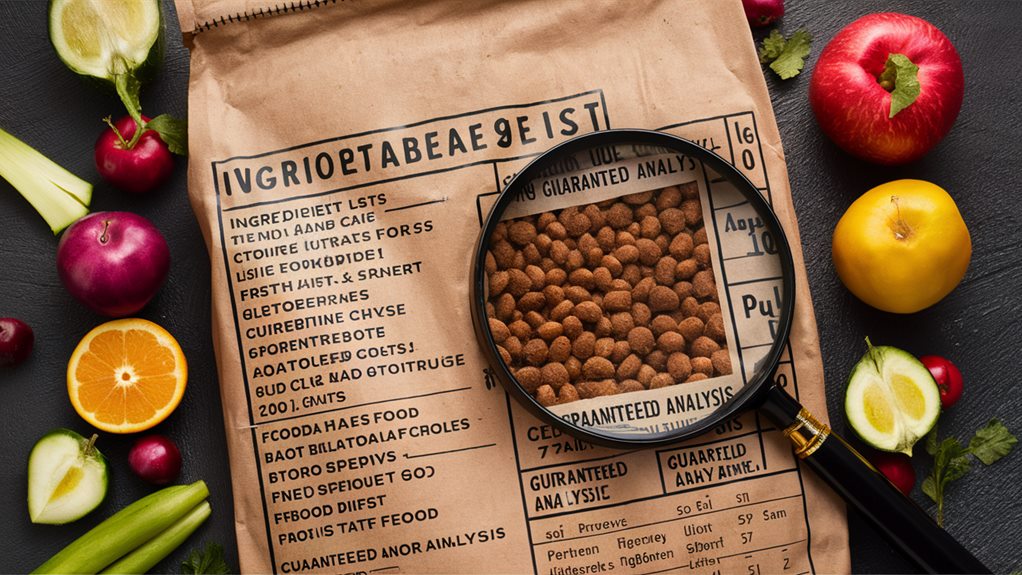
Making informed choices about your pet's food is essential for their overall health and well-being. When you read pet food labels, you need to focus on key factors that influence your furry friend's nutrition. Start with ingredient sourcing. High-quality ingredients are vital; look for whole foods that are recognizable and sourced from reputable suppliers. Avoid products with vague terms like "meat by-products," which can hide low-quality ingredients.
Next, consider the nutrient balance in the food. A well-balanced diet must include the right proportions of proteins, fats, carbohydrates, vitamins, and minerals tailored to your pet's specific needs. Check the Guaranteed Analysis section on the label to see the percentages of these nutrients.
Make sure the protein sources are high-quality and appropriate for your pet's age, size, and activity level.
Don't forget to research the manufacturer's reputation. Brands that prioritize transparency often provide information about their ingredient sourcing and nutritional philosophy. This not only helps you feel confident in what you're feeding your pet but also fosters a sense of community among responsible pet owners.
Frequently Asked Questions
How Often Should I Change My Pet's Food Brand?
You should consider adjusting your pet's food brand every six months to a year, balancing consistency vs. variety. Consistent nutrition helps maintain digestive health, while introducing new brands can prevent boredom and provide different nutrients.
When you do switch, adjust slowly over a week or so to avoid stomach upset. Mixing the old and new foods gradually allows your pet to adjust, ensuring they enjoy their meals without any digestive issues.
Can I Mix Different Pet Food Brands Together?
You can mix different pet food brands together, but it's important to maintain nutritional balance. Brand mixing can introduce various nutrients and flavors, which might keep your pet interested. However, be careful; not all brands have the same nutritional profiles, and sudden changes can upset your pet's digestion. Gradually combine the foods and monitor your pet's reaction.
Consulting with your vet can also assist you in creating a balanced diet for your furry friend.
Are Organic Pet Foods Healthier Than Conventional Ones?
When you're choosing between organic and conventional pet foods, consider the nutritional benefits and environmental impact. Organic foods often contain higher quality ingredients, which can lead to better overall health for your pet. They're typically free from synthetic additives and pesticides, making them a safer choice. Plus, supporting organic farming practices contributes to a healthier planet. Ultimately, your decision can reflect your values and commitment to your pet's well-being and the environment.
What Are the Signs of a Food Allergy in Pets?
When your furry friend starts scratching like there's no tomorrow, it could signal a food allergy. Common signs include itching, gastrointestinal upset, or skin irritations. To pinpoint the allergen, you might consider allergy testing or an elimination diet.
Observing symptoms closely is vital, and consulting with a veterinarian helps guarantee your pet gets the right care. Remember, understanding your pet's needs strengthens your bond and keeps them happy and healthy.
How Can I Tell if My Pet Is Allergic to Certain Ingredients?
To identify allergens in your pet, start by observing any unusual reactions after meals, like itching or gastrointestinal issues.
You might consider an elimination diet, where you remove common allergens like grains or certain proteins from their diet for a few weeks.
Gradually reintroduce one ingredient at a time to pinpoint the trigger.
Keeping a detailed journal of your pet's reactions can help you and your vet make informed decisions about their nutrition.
Conclusion
By understanding how to read pet food labels, you can make informed choices that promote your pet's health. Surprisingly, studies show that nearly 70% of pet owners don't fully comprehend the nutritional information on labels. This lack of understanding can lead to poor dietary choices. By decoding ingredient lists, analyzing guaranteed analysis, and recognizing AAFCO standards, you make sure your furry friend gets the best nutrition possible, tailored to their specific needs. Your pet's well-being depends on it!

